You must have the latest AZ-140 exam dumps to effectively prepare for the Microsoft Azure AZ-140 exam. How to have it, we have already considered it for you.
Please select the Pass4itSure AZ-140 exam dumps >> https://www.pass4itsure.com/az-140.html as a valid Microsoft AZ-140 exam material for easy preparation for the Configuring and Operating Windows Virtual Desktop on Microsoft Azure exam.
Pass4itSure AZ-140 exam dumps can help you easily prepare for the Configuring and Operating Windows Virtual Desktop on Microsoft Azure exam.

How do you understand the AZ-140 exam?
The AZ-140 exam has 40-60 questions in a multiple-choice format. The test languages are: Arabic (Saudi Arabia), German, English, Spanish, French, Indonesian (Indonesia), Italian, Japanese, Korean, Portuguese (Brazil), Russian, Chinese (Simplified), Chinese (Traditional). You will have a total of 120 minutes to complete the entire exam. The AZ-140 exam fee is also $165.
What are the resources for learning the AZ-140 exam?
- Deliver remote desktops and apps with Azure Virtual Desktop
- Configuring and Operating Microsoft Azure Virtual Desktop
- Pass4itSure AZ-140 exam dumps
Is the AZ-140 exam difficult? So how do you prepare?
The AZ-140 exam is not easy to pass, which means you need to have a thorough understanding of the exam and need to have new exam materials to prepare for the exam.
Pass4itSure AZ-140 exam dumps are the valid AZ-140 exam materials. Helps you easily prepare for the Configuring and Operating Windows Virtual Desktop on Microsoft Azure exam.
AZ-140 Free Dumps: Configuring and Operating Microsoft Azure Virtual Desktop Exam Questions Answers
1. Which two roles should you assign to Admin2 to meet the security requirements? Each correct answer presents part of the solution. NOTE: Each correct selection is worth one point.
A. Desktop Virtualization Host Pool Contributor
B. Desktop Virtualization Application Group Contributor
C. Desktop Virtualization Workspace Contributor
D. Desktop Virtualization Application Group Reader
E. User Access Administrator
Correct Answer: BC
Reference: https://docs.microsoft.com/en-us/azure/virtual-desktop/rbac
2. Your company has a single office and has 40 employees. You are planning an Azure Virtual Desktop deployment. The estimated user workloads are shown in the following table.

Half the users of each workload type work from home. All the users who work from home do NOT establish a VPN
connection to the office. Approximately how much bandwidth is needed between the office and Azure to support the
planned workloads?
A. 9.5 Mbps
B. 55 Mbps
C. 110 Mbps
D. 220 Mbps
Correct Answer: B
3. You have an Azure Virtual Desktop deployment. You implement FSLogix profile containers.
You need to ensure that the FSLogix profile containers are not used for specific users. What should you do?
A. Modify the local groups on each session host
B. Apply an Application Masking rule to each session host
C. Apply an AppLocker policy to each session host
D. Modify the RDP Properties of the host pool
Correct Answer: A
Reference: https://docs.microsoft.com/en-us/fslogix/configure-profile-container-tutorial
4. Your network contains an on-premises Active Directory domain and a Windows Virtual Desktop deployment. The computer accounts for all the session hosts are in an organizational unit (OU) named WVDHostsOU. All user accounts are in an OU named CorpUsers.
A domain administrator creates a Group Policy Object (GPO) named Policy1 that only contains user settings. The administrator links Policy1 to WVDHostsOU. You discover that when users sign in to the session hosts, none of the settings from Policy1 are applied. What should you configure to apply GPO settings to the users when they sign in to the session hosts?
A. loopback processing
B. FSLogix profiles
C. mandatory Roaming User Profiles
D. restricted groups
Correct Answer: A
Reference: https://www.linkedin.com/pulse/windows-virtual-desktop-remoteapps-jason-byway
5. You have a shared image gallery that contains the Windows 10 images shown in the following table.

You create an Azure Virtual Desktop deployment that has the following settings:
1. Host pool name: Pool1
2. Location: West US
3. Host pool type: Personal
Which images can you use for the session hosts?
A. Image1 only
B. Image1, Image2, Image3, and Image4
C. Image2 only
D. Image1 and Image2 only
E. Image1 and Image3 only
Correct Answer: E
Reference: https://azure.microsoft.com/en-in/blog/vm-image-blog-post/
6. DRAG DROP
You have a Windows Virtual Desktop deployment. You have a session host named Host1 that has the disk layout shown in the exhibit. (Click the Exhibit tab.)
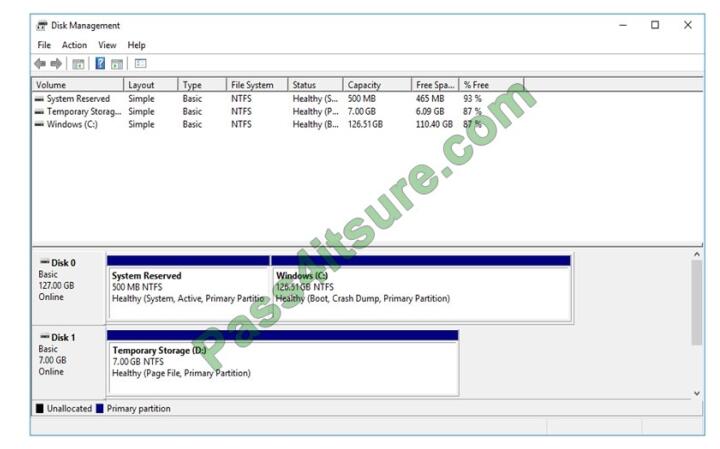
You plan to deploy an app that must be installed on D. The app requires 500 GB of disk space.
You need to add a new data disk that will be assigned the drive letter D. The solution must maintain the current performance of Host1.
Which four actions should you perform in sequence? To answer, move the appropriate actions from the list of actions to the answer area and arrange them in the correct order.
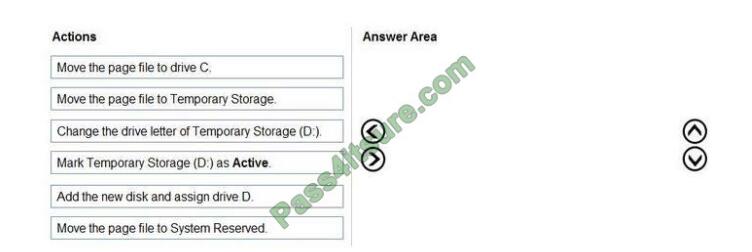
Correct Answer:
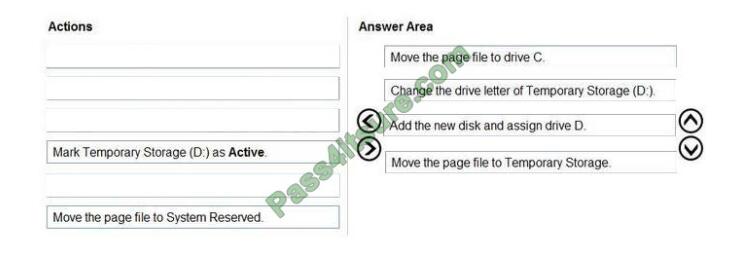
Reference: https://www.azurecorner.com/change-temporary-drive-azure-vm-use-d-persistent-data-disks/
7. You have a Windows Virtual Desktop host pool. You need to install Microsoft Antimalware for Azure on the session hosts. What should you do?
A. Add an extension to each session host.
B. From a Group Policy Object (GPO), enable Windows 10 security features.
C. Configure the RDP Properties of the host pool.
D. Sign in to each session host and install a Windows feature.
Correct Answer: A
Reference: https://docs.microsoft.com/en-us/azure/security/fundamentals/antimalware
Correct Answer: A
Reference: https://docs.microsoft.com/en-us/fslogix/overview
https://docs.microsoft.com/en-us/fslogix/configure-profile-container-tutorial#set-up-include-and-exclude- user-groups
9. You have an Azure Active Directory (Azure AD) tenant named contoso.com and an Azure virtual network named VNET1. To VNET1, you deploy an Azure Active Directory Domain Services (Azure AD DS) managed domain named litwareinc.com. To VNET1, you plan to deploy a Windows Virtual Desktop host pool named Pool1.
You need to ensure that you can deploy Windows 10 Enterprise host pools to Pool1. What should you do first?
A. Modify the settings of the litwareinc.com DNS zone.
B. Modify the DNS settings of VNET1.
C. Add a custom domain name to contoso.com.
D. Implement Azure AD Connect cloud sync.
Correct Answer: B
Reference: https://docs.microsoft.com/en-us/azure/active-directory-domain-services/tutorial-create-instance
10. You have an Azure Virtual Desktop host pool named Pool1 in the East US region. You have a storage account named storage1 that contains FSLogix profile containers. In the East US region, you have a shared image gallery named SG1 that contains a virtual machine image named Image1. Image1 is used to create new session hosts in Pool1.
You plan to deploy a new Azure Virtual Desktop host pool named Pool2 to the South India region.
You need to implement a session host deployment solution for Pool2 that meets the following requirements:
1. Image1 must replicate in the South India region.
2. The session hosts in Pool2 must be based on Image1.
3. Changes to Image1 must be available in the South India and East US regions. What should you include in the solution?
A. Create a new shared image gallery named SIG2 in the South India region. Upload a copy of Image1 to SIG2.
B. Create a new Azure Storage account named storage2 in the South India region. Copy Image1 to a shared folder in storage2.
C. From SIG1, update the replication for the latest image version of Image1.
D. Configure geo-redundant storage (GRS) replication for storage1. Copy the VHD file of Image1 to the FSLogix profile container.
Correct Answer: C
Reference: https://docs.microsoft.com/en-us/azure/virtual-machines/shared-image-galleries
11. HOTSPOT Which users can create Pool4, and which users can join session hosts to the domain? To answer, select the appropriate options in the answer area.
NOTE: Each correct selection is worth one point.
Hot Area:
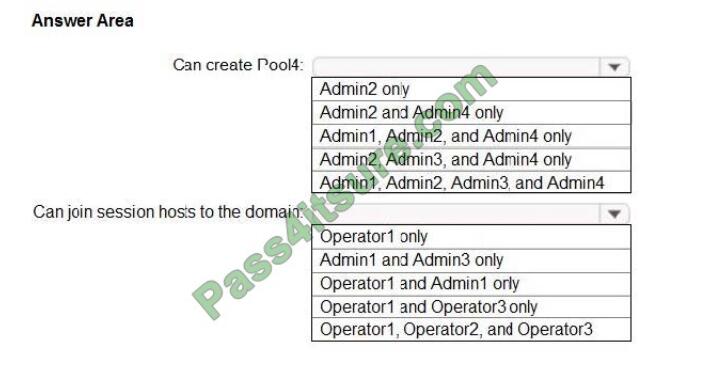
Correct Answer:
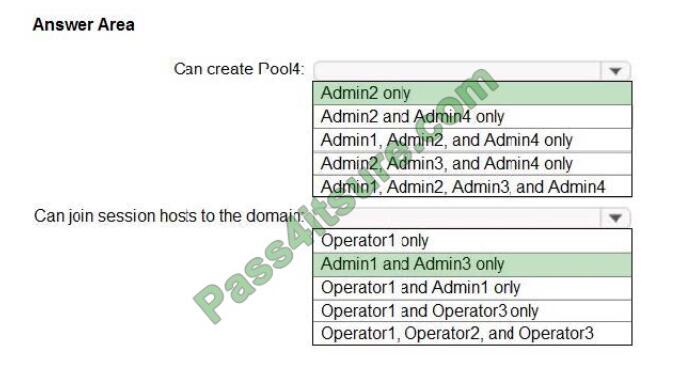
12. You have an Azure Virtual Desktop deployment. You need to create a PowerShell script to sign users out of a specific session host before you perform a maintenance task. Which PowerShell module should you load in the script?
A. Az.Automation
B. Az.Compute
C. Az.Maintenance
D. Az.DesktopVirtualization
Correct Answer: D
Reference: https://docs.microsoft.com/enus/powershell/module/az.desktopvirtualization/?view=azps-6.6.0#desktopvirtualization https://techgenix.com/logging-offand-removing-wvd-user-sessions/
13. DRAG DROP You have a Windows Virtual Desktop host pool named Pool1. Pool1 contains session hosts that use FSLogix profile containers hosted in Azure NetApp Files volumes. You need to back up profile files by using snapshots.
Which three actions should you perform in sequence? To answer, move the appropriate actions from the list of actions to the answer area and arrange them in the correct order.
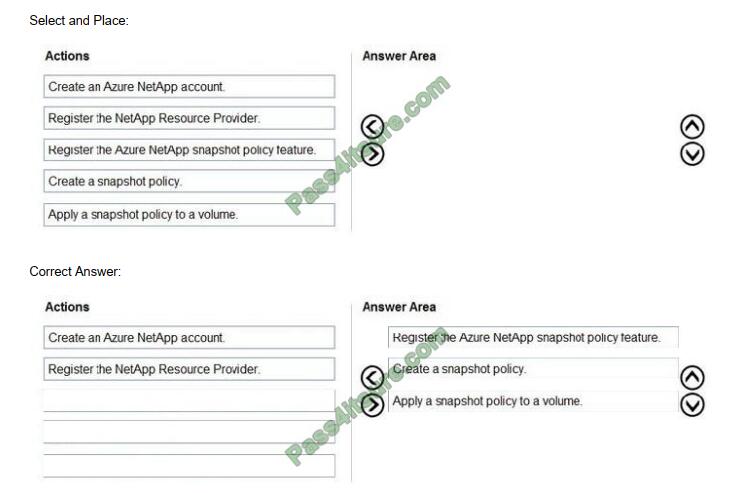
Reference: https://docs.microsoft.com/en-us/azure/azure-netapp-files/azure-netapp-files-manage-snapshots
For more AZ-140 exam questions, this website.
Free AZ-140 Dumps Online Download: https://drive.google.com/file/d/1-P0I-UbHEQd2rdxTGbG0hpZTIOyNwHc9/view?usp=sharing